How to Build a Winning PIM Strategy for eCommerce Growth

How to Build a Winning PIM Strategy for eCommerce Growth
In today’s rapidly evolving eCommerce landscape, businesses that carve out a clear and actionable product information management (PIM) strategy stand out.
A well‑defined PIM strategy enables you to centralize product data, enrich it for multiple channels, and distribute it consistently. It also helps accelerate time to market, reducing returns, and boosting customer trust.
For organisations using platforms like Ergonode, the stakes and the potential gains are even higher.
In this article, you’ll learn exactly what a winning PIM strategy looks like, how to assess your current maturity, and step through building a scalable, future‑proof roadmap aligned with best practices.
By the end, you’ll have a robust framework to implement or optimize your PIM strategy for eCommerce growth.
What Is a PIM Strategy and Why It Matters
A PIM strategy is the comprehensive plan that defines how you will use product information management as a competitive asset. It encompasses the processes, data model, governance, tools, integrations, and metrics by which product information is managed, enriched and distributed across your channels.
Why does it matter?
For eCommerce businesses, inconsistent, incomplete, or inaccurate product data can compromise customer experience, undermine conversion rates and increase operational friction.
Conversely, a PIM strategy that centralizes data, enforces governance, and delivers channel‑ready content helps organisations scale efficiently and win across multiple sales touchpoints.
Assess Current Product Data Maturity
Before charting a PIM roadmap, you must know your starting point.
Begin by assessing your current product data maturity across five dimensions:
- Data Completeness: Are all required attributes filled for each SKU?
- Data Accuracy: Are values correct, consistent and validated?
- Taxonomy and Structure: Do you have a well‑designed attribute hierarchy, category tree and inheritance model?
- Asset Coverage: Are digital assets (images, videos, documents) linked and enriched for all products?
- Integrations & Syndication: Are your product data flows consistent between ERP, catalogue, marketplaces and the PIM platform?
Score your organisation as Basic, Intermediate or Advanced based on how many of these dimensions you meet and the consistency of your workflows.
Conduct stakeholder interviews across marketing, product, IT and operations to map data ownership, current pain points and bottlenecks. The insight you gather becomes your baseline for the roadmap that follows.
Define Clear Business Goals and Success Metrics
Transforming your PIM strategy into actionable results requires setting clear business goals and measurable success metrics.
Below is a suggested table to include in your article for easy reference:
Use this table to help your team translate goals into KPIs, set realistic targets and track progress. Align the goals with your eCommerce growth objectives, whether that’s expanding marketplaces, launching new categories, or global expansion.
Design Your PIM Data Model and Governance
A scalable PIM strategy hinges on a robust data model and governance structure. Start with your attribute taxonomy and inheritance design: define mandatory vs optional attributes, group them by category, and establish product‑family relationships.
Then, move to asset linking. Ensure images, videos and documents are properly associated with SKUs and variants.
Integration with a DAM (digital asset management) system is often a prerequisite.
A governance framework sets the rules for data ownership, change control, and validation workflows. Consider including a RACI (Responsible‑Accountable‑Consulted‑Informed) matrix where, for example, Product Owner is Responsible, Data Governance Lead is Accountable, Merchandising is Consulted, and IT is Informed.
This supports consistent data entry, fewer errors and streamlined approvals.
Choose the Right PIM Architecture and Integrations
Selecting the right architecture and integration strategy is crucial for the success of your PIM strategy, especially as you scale.
Cloud‑based, headless PIM platforms like Ergonode offer significant advantages: scalability, API‑first data flexibility, and ready integration with eCommerce platforms, marketplaces, ERP systems and third‑party services.
When choosing your architecture, compare cloud vs on‑premise solutions, the availability of headless (API) capabilities, and how well the platform integrates (via connectors or custom APIs) with your tech stack. A strong PIM should allow you to centralize product data and distribute it seamlessly across channels without duplication or heavy middleware.
Prioritise integration of your ERP, CRM, marketplace feeds and DAM early. These become your foundational data flows.
Build an Implementation Roadmap
Below is a step‑by‑step roadmap you can apply to roll out your PIM strategy:
- Project Kick‑off and Discovery: Define scope, stakeholders, goals, and conduct a current‑state data audit.
- Data Model Design and Taxonomy Build: Build attribute taxonomy, inheritance logic, category tree, digital asset linking.
- Integration and Ingestion: Connect ERP, supplier feeds, DAM, marketplace data to the PIM. Cleanse and migrate legacy data.
- Data Enrichment and Asset Linking: Enrich SKUs with descriptions, images, videos, translations, channel‑specific content.
- Channel Mapping and Export Formats: Define how data will be exported: templates for each channel (webstore, marketplace, mobile app).
- Quality Assurance, User Training, Cut‑over: Test workflows, validate data, train users across merchandising, marketing and IT teams.
- Post‑Launch Optimisation and Maintenance: Monitor KPIs, run audits, refine taxonomy and data flows, and launch continuous improvement cycles.
You can provide this roadmap as a printable checklist for teams to follow. Many PIM‑implementation guides note these stages as critical for success.
Best Practices for PIM Adoption and Change Management

Technology alone does not guarantee success.
Secure executive sponsorship early, form a cross‑functional steering committee (merchandising, marketing, IT, operations), and launch role‑based training sessions for all users (data stewards, content creators, system administrators).
- Start with a pilot category or product line to gain early wins and build momentum.
- Recognise champions in different teams who advocate for the new workflows.
- Reinforce governance by defining clear workflows, automation rules and validation logic.
Adoption will be stronger when users see clear benefits such as faster launches, fewer corrections and smoother cross‑department collaboration.
Common Implementation Pitfalls and How to Avoid Them
Despite best intentions, many PIM projects stumble.
Here are common pitfalls and how to avoid them:
Pitfall: Skipping the data audit phase.
Remedy: Conduct thorough discovery and data profiling upfront to avoid migrating poor‑quality data.
Pitfall: Weak governance and unclear data ownership.
Remedy: Create governance frameworks early, define roles, implement validation rules and enforce ownership.
Pitfall: Trying to migrate everything at once.
Remedy: Use a pilot approach, prioritise high‑value categories and gradually expand to full catalogue.
Pitfall: Ignoring channel‑specific requirements.
Remedy: Map out each channel’s attribute templates, export formats and localisations early in the roadmap.
By spotting these risks ahead of time, you’ll increase your chances of a smooth rollout and sustained success.
Optimization and Ongoing Maintenance
A PIM strategy does not end at launch. That’s why it’s important to set a maintenance cadence: schedule quarterly taxonomy reviews, monthly data audits, and continuous enrichment workflows.
Automate validation rules and enrichment suggestions where possible using your PIM’s built‑in capabilities or third‑party tools.
Monitor your success metrics regularly and run A/B tests on product pages to see how richer content impacts conversions. Use dashboards to track data completeness, time to publish SKUs, conversion lifts, and returns reduction.
A strong ongoing plan helps maintain momentum, supports new channels or markets, and ensures your product information remains a competitive asset.
Quick PIM Strategy Checklist
Here’s a compact takeaway of the key elements:
- Audit your current product data maturity
- Set business goals and measurable KPIs
- Design a scalable data model with governance
- Choose cloud‑based, API‑first architecture and integrations
- Build and follow a detailed implementation roadmap
- Drive adoption with change management practices
- Avoid common pitfalls by planning ahead
- Maintain momentum with ongoing optimisation
Example Implementation Timeline for a Mid‑Market eCommerce Team
Month 1–2: Discovery, stakeholder alignment, data audit, business goal definition.
Month 3–4: Data model design, taxonomy build, integrations with ERP and sample feeds.
Month 5–6: Enrichment pilot for core category, user training, QA testing, launch to live channel.
Month 7+: Expand coverage to full catalogue, add additional channels/markets, monitor KPIs, refine process.
Take Your PIM Strategy to the Next Level
Implementing a robust PIM strategy is a transformation that empowers your business to deliver consistent, accurate, and enriched product information across every channel.
By centralizing your data, you position your eCommerce operations for scalable growth and measurable success.
Define clear governance, and follow a structured roadmap. Start building a PIM framework that drives efficiency, enhances customer experience, and sets your brand apart in a competitive marketplace.






